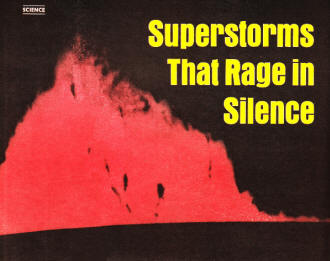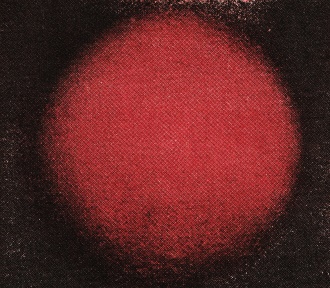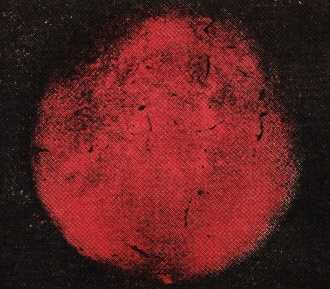| May 1968 Popular Mechanics |
 [Table
of Contents] [Table
of Contents]
Wax nostalgic over early technology. See articles from
Popular Mechanics, published 1902 - 2021. All copyrights are hereby acknowledged. |
You have likely heard of the
International Geophysical Year (year and a half, actually), which was timed
to coincide with maximum solar activity beginning in June 30, 1957, but have you
heard of the
Second Polar Year, a 13-month period that began in August 1932? It was
conducted at a time when long range radio communications was becoming a major
geopolitical necessity and scientists needed to better understand the phenomena
of ionization in the Earth's upper atmosphere (named as a result - you guessed
it - the ionosphere). Critical World War II radio communications were hampered
by atmospheric electrical disturbances; likewise during the Korean War. When the Space Age was in its early
years, learning about how radiation in all forms affect both electrical and biological
(i.e., human) entities was essential in order to mitigate harmful effects and assure
their safety. This "Superstorms That Rage in Silence" article in a 1968 issue of
Popular Mechanics magazine discusses the consequences of solar activity
on Earth-based systems - particularly the power distribution grid.
Superstorms that Rage in Silence

An eruptive arch prominence, a hydrogen gas cloud, rises more
than 60,000 miles above surface of sun.
By Lyman M. Nash
Photos by Sacramento Peak Observatory, U.S. Air Force Office of Aerospace Research
Magnetic storms black out cities, raise havoc with radio and television, and
cut off airline pilots from their ground communication. Solar flares are the cause
- and new disturbances lie ahead.
Shortly before 8:30 on the crisp Monday evening of Feb. 10, a storm of savage
intensity struck New York City and within a minute engulfed the entire earth. Transatlantic
radio was wiped out. Ships lost contact with shore stations and with each other.
Airplanes aloft were limited to line-of-sight communications only. Teletype and
Western Union messages were so garbled translation was often impossible. Low-altitude
radiation tripled, while tremendous electric currents surging beneath the sea turned
oceans into huge storage batteries.
The storm was the worst of its kind ever recorded, yet few people knew about
it until they read their morning paper. Visible evidence of its fury was limited
to wild scratchings on magnetograph charts, wavering compass needles and a magnificent
auroral display stretching from polar regions almost to the equator.
No doubt such storms wracked the Earth long before the first life struggled from
the primordial sea. Their existence, however, went virtually unnoticed until about
a century ago, when the equipment they affect came into common use.

Sun at Solar Minimum: Few sunspots (flares) are seen. In 11-year
cycle, sun returns to solar maximum.

Solar Maximum: Bright areas (flares) emit Gamma and X-rays, disturb
ionosphere, cause radio blackouts.
Since then magnetic storms, as they are called, have become a growing nuisance,
periodically interrupting the smooth conduct of our electrically oriented lives.
They cancel long distance phone calls, scramble telegrams and silence the best radios.
They build up power overloads to plunge whole cities into darkness. Nor is the situation
likely to get better. As we become more electromagnetically sophisticated, we will
be increasingly at their mercy.
Each second the sun blows a million tons of matter into space. These charged
particles spread out in all directions to form the "solar wind." When this nears
the Earth, the latter's magnetic field deflects the particles into the Van Allen
belts. Save for a few high-energy particles that leak through, our magnetic field
shields us from cosmic radiation.
What, then, causes magnetic storms? The only thing generally agreed is that they
stem from solar flares - explosions releasing Energy millions of times greater than
the most powerful hydrogen bomb. This energy, in the shape of a gigantic cloud of
charged particles, hurtles through space at 1000 miles per second. If on a collision
course with earth, it deals the planet such a magnetic jolt that magnetic pull might
vary more than 10 per cent, compass needles will swing seven or eight degrees, and
the ionosphere will go haywire.
Magnetic storms occur most frequently and are most violent when sunspot activity
is at a peak sunspots wax, wane, and wax again over a period that averages out at
11 years, though as many as 17 years have elapsed between peak periods. At the start
of a cycle, spots appear only in the sun's upper latitudes. As activity increases
they show up ever closer to the equator. After building to a peak, which may see
the sun literally speckled with spots, they gradually subside. Midway through a
cycle there may be no sunspots at all.
Sunspots were first observed in the early 1600s, shortly after invention of the
telescope. Beyond the discovery that they have a magnetic field thousands of times
stronger than the sun itself, we don't know much more about them today. They appear
dark simply because they are 2000° cooler than the rest of the sun's surface,
or "photo-sphere," where the temperature is 6000° C. (about 10,000° F.)
Seen alone, a sunspot would glow far brighter than the brightest arc lamp.
When seen through a helioscope, which permits telescopic viewing of the sun without
injury to the eye, a sunspot looks like a vortex with stuff falling into it. Some
are so large they cover billions of square miles of the photosphere. A particular
spot might last less than a day, or be visible for months. Some emit flares, some
do not, but apparently only flaring sunspots cause magnetic storms.
The strange effects of sunspots and magnetic storms first came under international
study during the Second Polar Year, a 13-month period from Aug. 1, 1932, to Aug.
31, 1933. (The Polar Year, a half-century before, had confined itself mainly to
terrestrial matters.) But a worldwide depression put a financial crimp on the project,
and solar activity was at a minimum, so there weren't many sunspots to study. Despite
this, the knowledge acquired when applied to radio alone was worth many millions
of dollars.
A quarter-century later the International Geophysical Year began. Timed to coincide
with maximum solar activity, it started June 30, 1957, and ended Dec. 31, 1958.
And it kicked off, magnetically speaking, with a bang.
At 4:00 a.m. on the first day a magnetic storm severely disrupted radio communication
between America and Europe. At 5:00 a.m. a brilliant aurora, thousands of miles
long, swept across the northern United States. Unfortunately, the storm came too
soon for many of the IGY's more elaborate programs.
Which is why, in Feb. 1958, eager scientists around the world had their eyes
and ears trained on the sun. Early that month a group of sunspots covering three
billion square miles began developing near the sun's central meridian. Then, at
five minutes past 1:00 EST, on Sunday afternoon, Feb. 9, the Harvard Radio Astronomy
Station at Fort Davis, Tex., picked up a loud crackling sound on 458 megacycles,
a frequency favored by the sun. Three minutes later visual observers, scattered
over the daylight half of the earth, saw a solar flare of dazzling brilliance erupt
near those sunspots, one of the largest groups ever seen.
As the flare developed the radio noise grew to a steady roar and was soon heard
on other frequencies, as well. After almost two hours, the flare died and the solar
radio quit broadcasting. For the sun, at least, the show was over.
According to the most widely accepted theory, some solar flares emit only radio
noise while others also eject what geophysicists call "corpuscles," submicroscopic
charged particles. If this flare had ejected such a cloud - aimed at Earth - a magnetic
storm could be expected in about a day.
At the IGY World Warning Agency, Fort Belvoir, Va., an alert was sent to scientists
of the 66 nations taking part advising them to look for anything out of the geophysical
norm. But it was decided not to call a Special World Interval, which automatically
would put into operation costly and highly complex experiments. Forty larger flares
already had been seen during the IGY, and there had been seven SWIs.
As it turned out, this was a mistake. The flare had indeed ejected a cloud of
corpuscles-headed straight for Earth.
Twenty-eight hours later, at precisely 8:26 p.m. New York time, Feb. 10, the
cloud and the Earth arrived at the same point in space, causing a slight jiggle
on the recording charts of magnetic instruments. The jiggles increased rapidly,
and by 8:49 were sweeping right off the page. A bright aurora appeared over Minneapolis,
and all magnetic hell broke loose.
Normally auroras are confined to two narrow bands encircling the globe about
1700 miles from either pole. Aurora borealis, in the northern hemisphere, passes
through central Alaska, Hudson Bay, southern Greenland, upper Scandinavia and Siberia.
In the southern hemisphere aurora australis skirts Antarctica.

Cloud of charged particles, striking Earth in 1958, caused violent
magnetic storm and radio blackouts.
During a magnetic storm, though, the auroras spread into the temperate zones.
If the storm is particularly fierce, auroras can even be seen flickering briefly
yet brightly deep into the tropics.
Although auroras have been well studied, they are a long way from being understood,
and there is no foolproof theory to explain them. About all that is known for sure
is that the presence of an aurora indicates a state of turbulence in the ionosphere,
a region above the stratosphere containing tiny particles of electrically charged
air.
Within the ionosphere are the Kennelly-Heaviside and Appleton layers which act
as mirrors, reflecting radio waves of certain frequencies back to earth. But for
them, a series of relay stations would be needed to broadcast long distances, since
radio waves travel in a straight line and do not follow the curvature of the Earth.
During a magnetic storm, however, the layers seem to go to pieces. Radio waves are
gobbled up by the ionosphere and distant radio communication ceases.
So at 8:50 p.m., with the aurora spreading, transatlantic radio contact abruptly
faded. Radio companies tried to keep in touch with Paris by routing messages to
South America and over to Tangiers, thus avoiding the turbulent ionosphere above
the North Atlantic. Sporadic contact was maintained in this manner until 11:00,
then for the next hour and a half there was no contact at all.
Meanwhile, the breathtaking aurora continued growing and at 9:00 p.m., was seen
as a faint pinkish glow as far south as Georgia. As sheets of electricity tormenting
the ionosphere were duplicated within the Earth, submarine cables began being affected.
At 9:01 the Bell System's cables between Newfoundland and Scotland packed a potential
of 2650 volts. American voices heard in Europe varied from whispers to ear-shattering
squawks.
Still the storm's fury increased. Power overloads started tripping circuit breakers
and lights began blinking out on both sides of the Atlantic.
At 1:45 on the morning of Feb. 11, a faint aurora was seen near Mexico City.
At 2:00 a.m. the junior third officer aboard the President Taylor, steaming off
the Mexican coast on the same latitude, recorded that the northern sky was aglow
in red.
By then feeble radio contact had been regained with Paris, via South America-Tangiers.
But the countless ships plying the North Atlantic and the 100 or so airplanes flying
above it were still groping in radio blindness. Luckily, there was no marine disaster
necessitating an SOS, and pilots managed to keep pretty well on course and out of
danger by relaying messages from plane to plane.
At dawn on Feb. 11 the ionosphere reconstituted itself and the layers resumed
reflecting normally. However, that night radio communication was once more erratic
over the North Atlantic, and auroras were seen in several places. Not until 10:00
a.m. on the 12th was the great magnetic storm of 1958 declared over.
To produce all the phenomena observed it was estimated the cloud of charged particles
encountered by the Earth must have been 46 million miles long and 23 million miles
wide. The aurora it caused was calculated as being 5800 miles long in an east-west
direction, 400 miles wide, 360 miles thick, and starting at an altitude of 120 miles.
While the storm threw some new light on the nature of the ionosphere and the
Earth's magnetic field, it left most old questions unanswered. We still don't know
what makes aurora's shine, or what causes the ionosphere to go haywire during a
magnetic storm. Sunspots remain as mysterious as ever, though it is now thought
that a sudden breakdown of a spot's magnetic field permits the flare's energy to
escape into space. Some scientists feel that if we ever get to the bottom of these
mysteries we may be well on the way to solving the secret of the universe. One thing
is certain. When solar activity again reaches a peak and the sun is dotted with
spots, there will be more magnetic storms, perhaps even greater than 1958. If the
sun holds to schedule, that should happen around 1969.
Posted October 26, 2023
|